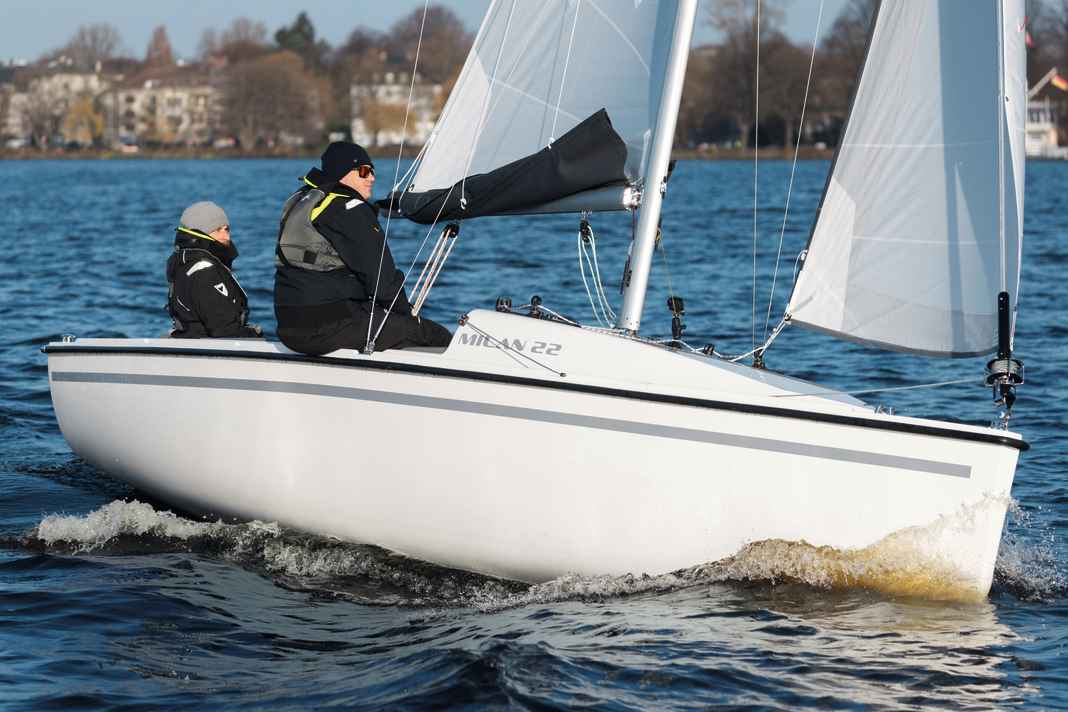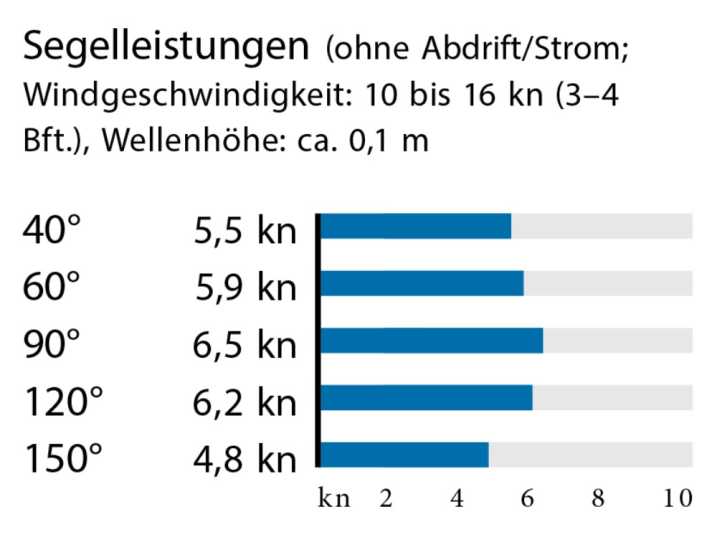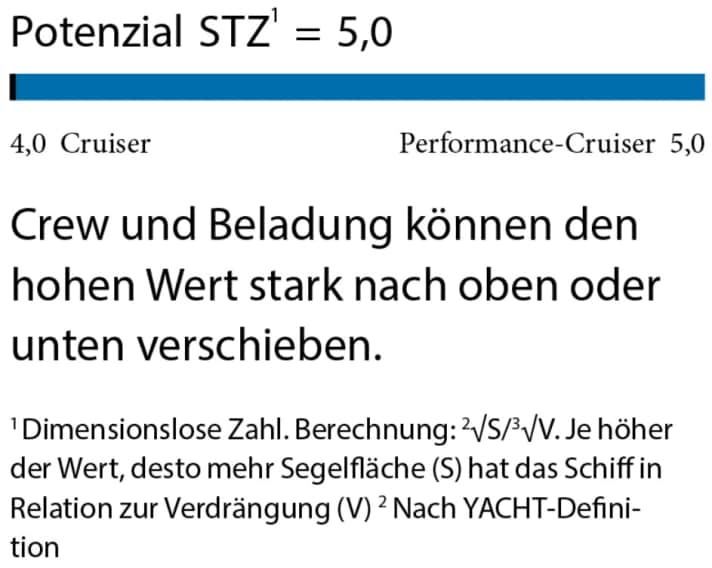Milan 22: Daysailer, small cruiser, travelling dinghy - versatility miracle in the test






- Milan 22: In addition to daysailing and travelling sailing, also for sailing schools
- Milan 22: Comprehensive space in the cockpit
- Price: This is how much the Milan 22 costs
- The measured values for the Milan 22 test
- The Milan 22 in detail
- Equipment and prices
- YACHT rating Milan 22
A cold, sunny day on Hamburg's Outer Alster. There is only one boat left at the end of the jetty. The Milan 22 is the last boat left in the water at the end of November. The daysailer is certainly designed for other seasons, but it still cuts a fine figure in the test.
The new boat is being built by the Neptun-Yachten shipyard in East Westphalia. The company has just celebrated its 60th anniversary. Unlike comparable manufacturers, the shipyard has remained true to small formats and continues to focus on dinghies and small cruisers to this day. The Neptun 22 with lifting roof was a hit in the 1970s and was once the best-selling yacht in Europe.
And now the new Milan 22, which initially makes a slightly tippy impression on the jetty, but this is no longer noticeable under sail. Even gusts of up to 17 knots blowing through late autumn Hamburg on this day, the Milan takes them in its stride. The ballast bomb on the lifting keel, which accounts for almost 19 per cent of the displacement of 798 kilograms, plays a large part in this. Although the ship initially lays on its side relatively quickly due to the rounded frame, the ballast limits further heeling from 15 to 20 degrees.
Milan 22: In addition to daysailing and travelling sailing, also for sailing schools
With the keel extended, the boat has a draught of 1.10 metres; for transport on the trailer, the fin is cranked up using the cable pull of a mobile device. Pascal Ernst, the designer and managing director of Neptun-Yachten, is currently working with his team on a keel design with a shallower draught. "We are still in the planning phase at this point, but we know that many of our potential customers sail in shallow water," he explains. They are therefore currently developing a keel version with the aim of reducing the draught to 65 to 70 centimetres.
In addition to use in sailing schools, the makers of Milan Daysailing see inland sailing and touring sailing as the core competence of their creation. However, ships will also be sailing close to the coast in the future.
Henry Jacobs from Hamburg, who helped develop the Milan 22 and is also in charge of sales, describes the target group: "Basically, it's a boat for everyone. It is suitable for all inland waterways, but can also easily be taken on holiday by a family on a trailer."
There is a 2.50-metre-long slip cabin for sailing on foot, which can be climbed into after the two-part bulkhead has been removed. At shoulder height, it is 69 centimetres high and 1.44 metres wide, although the mast support still divides the potential sleeping area. Towards the front, the slip berth tapers up to the stem. At the bow, it is 22 centimetres wide and 45 centimetres high.
Twelve units have already been sold
"In the future, we also want to offer cushions to make sleeping in the slip berth more comfortable," says Ernst. To make sleeping below deck more pleasant, there is also the option of a hatch in the foredeck. This would ventilate the foredeck and can be used to stow the gennaker.
In principle, it is therefore conceivable to sleep regularly on the Milan 22. However, it is advisable to purchase a cockpit tent to keep the bags dry overnight. The space in the slip cabin is too small for stowage, two people and possibly a cool box. However, there is a storage compartment below deck. With a length of 1.02 metres, a width of 63 centimetres and a depth of 31 centimetres, the compartment would be ideal for storing batteries. An electric pod drive from ePropulsion is also on the list of options. "We are still developing a mechanical device that will allow the drive to be folded away," says Pascal Ernst. According to him, they are in the final stages of development and the system will also be used in other boats from the shipyard. "However, we have already delivered a Milan 22 with a pod drive that cannot be retracted. Recuperation is more important to the customer," Ernst continues.
"It is important to us that the boat can be designed according to our customers' ideas," comments Henry Jacobs on the options for customising the boat. For example, the gelcoat can be ordered in any RAL colour. "We have our own mixing plant for gel coats in the company," says Ernst. He also emphasises: "We use ISO/NPG gelcoat, which is why we have no problems with osmosis. We also use high-quality ISO/NPG resin for all layers. This means there is no need for a waterproof coating of epoxy primer under the antifouling."
In future, the Milan 22 will be produced entirely in Germany. At the moment, the GRP work is still being carried out in Poland, where Neptun Yachts bought Deltania Yachts and its production facility in 2020. "In January, we will then bring the mould to East Westphalia and produce the Milan entirely in Germany," explains Ernst. Final assembly is already taking place at the site in Rheda Wiedenbrück.
Milan 22: Comprehensive space in the cockpit
The enterprising managing director and designer explains the approach to his work: "We build every new mould completely out of wood. Although we also develop ideas on the computer, the original model is then also built from MDF."
It took less than a year from the initial idea of building the Milan 22 to the finished boat number one. "We have everything ready so that we can produce 2.5 boats per week," says Ernst. So there are still some orders to be realised before the start of the season.
"We realise from the good demand that there is a market for this category of ship," says Ernst about the positive reactions from his first prospective customers. The shipyard boss also reports that he has already sold twelve Milans. Ernst and Jacobs will be bringing a Milan 22 with a gennaker pole to boot in Düsseldorf.
What visitors will notice is the extensive range of seats in the cockpit. There is room for six people between the companionway and the tiller. The benches are each 2.50 metres long (at the front edge) and 2.72 metres long (at the backrest). While the seating without cushions is between 38 and 42 centimetres deep, the space for sitting with cushions is limited to a depth of 33 to 37 centimetres. The backrest is 25 centimetres high and the seat height is 40 centimetres. These are dimensions that are synonymous with comfort.
Production currently in Poland
Two voluminous storage boxes are located directly under the Velcro-fastened upholstery and the seat bench. The rear one is 1.11 metres long, 23.5 centimetres deep and 31 centimetres high, while the front one is just under two centimetres shorter at 1.09 metres, 22 centimetres deep and 32 centimetres high.
Just like the hull, the Milan's sails are manufactured in Poland. The basic price of 27,800 euros includes the jib and a square top mainsail. The square profile in the top provides more surface area and efficiency and is possible because there is no backstay. "However, we can also supply foil sails or even carbon fibre sails instead of the Dacron sail," explains Henry Jacobs.
The rig on the tested boat is different from the one used in series production; in future, designer Pascal Ernst and his team will be using aluminium masts from Seldén. A striking feature of the test on Hamburg's Outer Alster: despite many attempts to get more pressure on the luff of the jib, the forestay sagged too much. This problem is detrimental to performance, but should be remedied by the new, expectedly more stable profile from the Swedish manufacturer.
The Milan 22 convinces in many places with good design ideas
Another issue in the test: the rudder has play. This was particularly noticeable when turning, as the Milan was a little jerky to steer at times. As a result, the manoeuvres in particular could not be steered cleanly. But this problem should also be resolved in the following boats, as Pascal Ernst explained: "It is possible that this is related to the upper pivot point bearing. We saw during final assembly that it had a little bit of play. But I will definitely have a look at it and sort out the problem."
He has nothing more to do with the finish. Those who attach particular importance to workmanship will be delighted with many of the corners. The upper half of the bulkhead, for example, closes via a "soft close". So if you want to close the boat, you don't have to operate any mechanism manually. Instead, the bulkhead is closed with a little more force. This makes for a great product experience; such details are particularly rare in the category of daysailers under seven metres.
The makers of the Milan 22 also attach great importance to the fact that their customers can still customise the boat to their needs afterwards. For example, the companionway has been angled slightly so that electrical instruments such as a log can be installed and easily read from the helmsman's position. In addition, ships ordered with the simple mainsheet option are also given some space to retrofit a traveller.
Considering that the Milan 22 is only 6.60 metres long, it seems rather expensive at first glance. However, it should be noted that the competition has also increased its prices massively in recent times. The Aira 22, which once cost around 14,000 euros, has become a whopping 10,000 euros more expensive. It is the daysailer that is by far the most similar to the Milan 22 and, at 24,700 euros, is also a little cheaper. The Pointer was even priced at 20,000 euros. Price increases of this magnitude are not least due to the sharp rise in energy costs and higher expenditure on raw materials and accessories. This is not exclusive to sailing yachts of this size and simple design; it affects the entire shipyard sector and makes used boats more interesting again.
Price: This is how much the Milan 22 costs
The cost of a Viko S 21, for example, has risen by almost 10,000 euros since our test eight years ago. This means that the price has almost doubled. Even for a Polyvalk, which offers no berth at all, prospective buyers now have to pay 21,500 euros.
The price of the Milan 22 is therefore high, but comparatively fair, especially for a boat made in Germany. There are still a few minor issues that the developers should rectify on subsequent boats in the series, such as the aforementioned play in the rudder system or the mast being too soft. However, the test did not reveal any fundamental problems that could not be rectified.
The new daysailer may not be for die-hard regatta sailors, but it is aimed at a much larger target group. The Milan 22 is particularly suitable for the many small and large inland sailing areas due to its size, easy handling and variable draught. The boat is also ideal for sailing schools, families and as an introduction to a career as a yacht owner. Finally, the boat can also be easily towed on holiday. For example, to explore coastal areas on short trips.
The measured values for the Milan 22 test


The Milan 22 in detail
Technical data
- Design engineer: Pascal Ernst
- CE design category: C
- Torso length: 6,60 m
- Total length w. Spriet: 7,60 m
- Waterline length: 6,43 m
- Width: 2,30 m
- Draught (lifting keel): 1,10 m
- Mast height above WL: 8,85 m
- Theoretical torso speed: 6.1 kn
- Weight: 798 kg
- Ballast/proportion: 150 kg/19 %
- Mainsail: 14,0 m²
- Foresail: 8,0 m²
- Gennaker: 28,0 m²
- Interior bunk: 2.50 x 1.44 x 0.22 m
Hull and deck construction
Solid laminate hand lay-up process with ISO/NPG resins and gelcoat.
Processing
The finish looks very good and the build quality is impressive. The forecastle boxes are inner shells, so equipment does not disappear between the deck and hull.
Layout
The cockpit is very large and super comfortable with optional cushions. However, with the foresheet on the superstructure, the Milan 22 is not suitable for single-handed sailing.
Rig
The mast seems a little soft without the backstay, and the luff sags too much in gusts. In future, the Milan will be fitted with a Seldén rig.
Equipment and prices
- Base price ex shipyard: 27.800 €
- Price ready to sail*: 27.800 €
- Guarantee/against osmosis: 5/10 years
As of 01/2025, how the prices shown are defined can be found here!
Shipyard
- Neptun-Yachten GmbH, Rheda-Wiedenbrück
- neptun-yachts.net
Distribution
- Henry Jacobs GmbH, Hamburg
- milan-boats.com
YACHT rating Milan 22
The Milan 22 comes without many trim options and bells and whistles. If you're looking for a simple boat that's easy to travel with, you should consider this boat.
Design and concept
Various applications
Also suitable for families
Robust and beginner-friendly
Sailing performance and trim
Good-natured even in the gusts
Simple sailing
Slight play in the rudder
Living and finishing quality
Robust construction
Bunk available
Slip bunk very narrow
Equipment and technology
High-quality fittings
Pod drive optional

